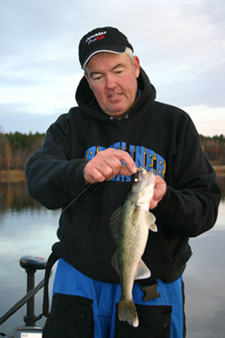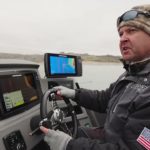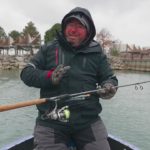Jigging Up Late Season Walleyes
 One of the most endearing aspects of late season walleye angling is its simplicity. In this complicated fast paced world we’re living in it’s nice to get back to the basics. Successful fall fishing requires a minimal amount of gear and thought. With a handful of jigs, a few minnows, and a good depth finder you’re in business. Before fall gives way to the onslaught of winter anglers have the opportunity to cash in on some fantastic fishing.
One of the most endearing aspects of late season walleye angling is its simplicity. In this complicated fast paced world we’re living in it’s nice to get back to the basics. Successful fall fishing requires a minimal amount of gear and thought. With a handful of jigs, a few minnows, and a good depth finder you’re in business. Before fall gives way to the onslaught of winter anglers have the opportunity to cash in on some fantastic fishing.
The ravages of the fall turnover can turn a walleyes world upside down and make for some awful tough fishing conditions. Even shallow lakes that don’t “officially” turnover still go through a cooling off process and it can take a little time for a fish’s body to adjust to the new, colder water temps. But soon after things start to settle down, and walleye anglers can expect to see definite improvements in walleye activity.
After the fall adjustment walleyes go on a feeding binge that can last right through the early season ice fishing season. One of the shortcuts to finding fall walleyes is knowing where they are historically caught through the ice. Instead of waiting for hard water; open water anglers can beat the ice brigade to the punch and cash in on peak fishing conditions. Early season ice action can center on drop offs, deeper hard bottom areas, weed edges, as well as transition lines where hard bottom meets soft. Those are the very same spots where late fall walleye anglers should begin their search.
Fish that are holding on or near any of the aforementioned spots can be readily scanned with good electronics like the Humminbird 997c. The 997c is a color graph with side scanning capabilities that can allow you to run a break or dropoff and quickly see if and where any fish are trying to hide out.
Because late fall ’eyes are easily marked they can be relatively easy to find. Instead of wasting a lot of time fishing where they’re not, anglers should key on classic spots that are definitely holding fish. A good plan of action incluides slowly cruise over the best looking spots, and keep going until you start to mark fish. Once you’ve marked a few it’s time to turn around and wet a line.
Late fall walleyes tend to bunch up and if you’re making one here and one there you’d probably do better by keeping on the move until you’ve marked at least a few fish holding close together. Once you’ve located a potential hangout you may elect to drop a marker to help keep your bearings. It’s easy to get a little confused, especially if your concentrating on your electronics. If you’re worried about other anglers moving in on your marker, try dropping a black one. They’re almost impossible to see, unless you get real close.
 One of the most consistent producers come late fall is vertical jigging. Working a jig and minnow straight up and down is a slow methodical method that allows an angler to really work over an area. The technique is simply a lift and drop of a jig, and you can actually walk the bait along the bottom. Although they may be active; late fall walleyes are not usually aggressive enough to chase down a fast moving bait. The lift and drop of a jig tipped with a minnow can be just the ticket for triggering cold water ’eyes. Medium sized minnows like fatheads, rainbow chubs, or shiners are perfect for tipping a jig. All will do the job but the shiner has the edge when faced with dark water conditions. The extra flash a shiner can provide seems to get more attention from deeper, dark water walleyes.
One of the most consistent producers come late fall is vertical jigging. Working a jig and minnow straight up and down is a slow methodical method that allows an angler to really work over an area. The technique is simply a lift and drop of a jig, and you can actually walk the bait along the bottom. Although they may be active; late fall walleyes are not usually aggressive enough to chase down a fast moving bait. The lift and drop of a jig tipped with a minnow can be just the ticket for triggering cold water ’eyes. Medium sized minnows like fatheads, rainbow chubs, or shiners are perfect for tipping a jig. All will do the job but the shiner has the edge when faced with dark water conditions. The extra flash a shiner can provide seems to get more attention from deeper, dark water walleyes.
Round headed jigs like a Northland Fireball in sizes ¼ to 3/8oz are the way to go. To tip the jig run the hook through the mouth and out the top of the minnow as far behind the head as you can. This method will help hold the minnow in place, especially when it’s exposed to the rigors of vertical jigging. A little twist on vertical jigging includes replacing the jig with a Buckshot Rattle Spoon, the very same bait you would use for ice fishing. Instead of the rhythmic lift and drop, the Buckshot requires more of a snapping motion to be effective.
If you can legally fish with another line you may want to deploy a live bait rig on a “dead rod”. A dead rod is nothing more than a rod rigged up and in the water but resting in a holder, instead of your hand. It’s difficult to concentrate on more than one jigging rod, and the dead rod let’s you effectively fish two baits at the same time. Longer softer action rods in the seven to eight foot range are recommended, like St. Croix’s Legend Series 7’6” spinning rod model TWS76MLF. In most cases you’ll know when the dead rod has been hit when it doubles over. Instead of letting a fish run you’re usually better off setting the hook immediately. The long rod can buy you some valuable time, time that may allow a fish to fully engulf the bait before it feels an unnatural resistance and rejects it. All of the aforementioned minnows can be effective when used with a live bait rig but if they’re available you can’t beat a red tail chub. Red tails elicit viscous strikes from every species of top of the line predators. I don’t know if it’s love or hate, but whatever the reason they really hit red tails hard. They will also let you know if there’s a predator close by. When you’re in the presence of hungry ’eyes red tails really start pumping, trying to swim to safety. You can see the action in the tip of your rod. If the rod tip starts throbbing; hang on. If you don’t get hit you may want to spend a little more time working the area over.
Look for late fall walleye fishing to become more and more consistent the closer you get to ice-up. Some of my best days have occurred when the lake I was fishing had a thin layer of ice starting to develop in the shallower bays. Another attractive aspect of late season angling is the fact that you can have an entire lake to yourself, and that’s as good as it gets.





